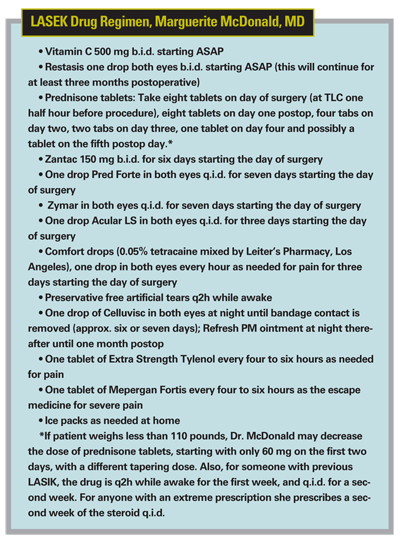Fears of ectasia have contributed to a renewed interest in surface ablation procedures such as PRK, epi-LASIK and LASEK. However, along with this renewed interest has come the recollection that surface procedures hurt and can cause haze. To combat these issues, veteran surface procedure proponents use numerous approaches, some involving procedural techniques, many involving pharmaceuticals. If you perform surface ablation and would like to bring your patients' subjective pain scores down from 10s to 3s or even lower, read on.
Avoiding Pain and Haze
Here are several surgeons' thoughts on specific aspects of their protocols:
• Easing postop pain. Lynbrook, N.Y., surgeon Marguerite McDonald, who holds a professorship at New Orleans' Tulane University, says she's gradually added agents to her surface ablation regimen until her patients' average pain scores dropped from 10 (on a zero to 10 scale of increasing pain) to a 2. (Her protocol appears in the box below.)
"It's a lot of pain, so it requires a lot of medicine," she says. "But the regimen does really work."
Though she's added several agents and/or techniques to her protocol for surface ablation, the one she points to as making the biggest difference in patient comfort is the use of steroids, both oral and topical.
"When I started doing research into the pain associated with surface ablation five years ago, I started off just using topical antibiotics, and pain scores were 10s," she recalls. "When I added a topical steroid in the form of Pred Forte, the average pain score dropped down to a 5. It cut it in half.
"Then I added more agents, originally the non-steroidal anti-inflammatory Voltaren (diclofenac), but the pain score took another large drop when I added oral steroids."
Dr. McDonald advocates slightly modifying the Pred Forte regimen for someone who's had LASIK previously, prescribing the drug q2h while awake for the first week, and q.i.d. for a second week. Also, for anyone with an extreme prescription, such as -6 D or above, +3 D or above or more than 3 D of cylinder, she prescribes a second week of the steroid q.i.d.
Mountain View
"I'll put people over 120 pounds or so on 40 mg prednisone starting the day before surgery and continuing for two days afterward," he explains. "Then, I taper them to 20 mg for two more days, then 10 mg for two. It comes to just under a week of oral prednisone." For patients who weigh less than 100 pounds, he prescribes a Medrol dose pack, starting the day before surgery. This is a less intense steroid course that comes in a convenient pack that details how many pills to take each day to taper the dose. He also uses the COX-2 inhibitor Celebrex 400 mg on the day of surgery and 200 mg b.i.d. for three days postop to help with patient comfort.
Most surface ablation surgeons will use chilled BSS during the procedure to promote comfort and to try to decrease the risk of haze, but James Salz, MD, of
"Before I take the epithelium off but after the alcohol application [for LASEK], I use frozen Weck-Cel sponges to chill the cornea for 10 seconds on, five seconds off, for 30 total seconds of cooling," he explains. "I do this to protect the corneal endothelium, because there's some evidence that holding a frozen sponge on the cornea for 30 straight seconds might damage it. Once the epithelium is off, I perform the ablation, rinse with chilled BSS and do the same thing again with another frozen sponge."
Some surface ablation surgeons are turning to a novel class of agent, the alpha 2 delta ligands, specifically the drugs Lyrica (pregabalin) and Neurontin (gabapentin). These agents were originally targeted at chronic pain sufferers and operate by inhibiting the ability of nerve endings to fire.
• Minimizing the haze risk. As a first line of defense, Dr. McDonald prescribes 500 mg vitamin C b.i.d. starting the day the patient books the surgery. She then has him take it for at least three months postop, as well. Dr. Volpicelli also believes in the merits of vitamin C. "I start them on 1000 mg vitamin C a week or two prior to surgery and continue it for at least six weeks afterward," he avers. The mechanism behind vitamin C's anti-haze properties isn't well-defined, but Dr. Volpicelli abhors haze so much he will do anything to avoid it.
Dr. Yee takes a unique tack for haze prevention. "When the patient comes in for his preop exam, we draw blood," he explains. "We prepare autologous serum at a concentration of 20 percent from his blood and then store it in a refrigerator at -8 degrees F until surgery. We then place it in single-use vials that we create by crimping sections of an IV tube, and the patient uses it q1h while awake during the postop re-epithelialization period when he's got the bandage lens on. When we remove the lens, he stops the serum drops." He says that, in his experience, it promotes healing and decreases the incidence of haze by suppressing cytokine formation.
Mitomycin-C is popular with surgeons with patients at risk for haze (usually those with previous refractive procedures or for ablations greater than around 60 to 70 µm). Dr. McDonald uses 0.02% mitomycin on a circular sponge that fits exactly the size of the ablation zone for a period of 15 seconds. "Before application, I squeeze the sponge so it feels almost dry," she says. "Then, I gently hold it in place for 15 seconds with a gloved finger. After application, I irrigate the area with 10 cc chilled BSS. It's really a very minimal exposure to that concentration of mitomycin."











